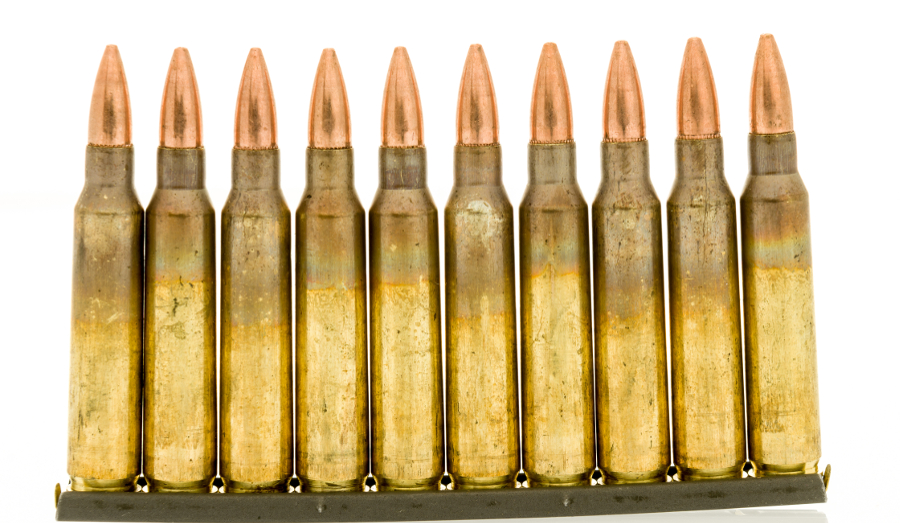From its origins as a cartridge developed for the US military’s small caliber high velocity trials, 5.56x45mm NATO/.223 Remington has become the most popular rifle cartridge in the United States today. In fact, it’s nearly the most popular cartridge overall, only just barely losing out to 9mm Luger.
Originally developed in the late 1950s, the .223 Remington was based on a lengthened .222 Remington case, with the shoulder pushed farther forward and with a shorter neck. Using the same .224”-diameter bullets as the .222 Remington, the .223 Remington was designed to push a 55-grain bullet at 3,300 feet per second in order to meet the military’s requirements for penetration of a steel helmet at 500 yards.
The combination of the .223 Remington cartridge and the AR-15/M16 rifle was not without its growing pains, however, as the adoption of the new rifle and cartridge just as the Vietnam War was in its infancy led to some initial difficulties. Fouling from the powder used in the initial cartridges led to stories of entire units being found dead trying to clear rifles that had jammed from buildup of carbon deposits.
Over the past several decades the .223 Remington rifle and AR-15/M16 platform have been fine-tuned to maximize their performance. The major problem with the initial loading of 55-grain bullets in the .223 Remington was that their wounding performance was predicated on the velocity achieved from the 20” barrel of the initial M16 rifles. As barrels began to grow shorter with the XM177-series and the M4 carbines, muzzle velocity dropped. The 55-grain bullet now left the muzzle with velocity as low as 2,600 feet per second, severely compromising its ability to fragment upon impact with muscle tissue, leading to narrow puncture wounds that failed to incapacitate targets.
NATO forces seeking enhanced penetration against armored targets upgraded the initial 55-grain bullet to a 62-grain bullet featuring a steel core penetrator. The new bullets, and the use of longer tracer bullets, necessitated a change in the twist rate of the M16 rifle’s rifling, from 1 in 12 inches to 1 in 7 inches.
Once again the use of a heavier bullet led to slower velocity, particularly from shorter barrels. As a result, many civilian shooters began to move to heavier bullets of 69 grains and 77 grains. Some military special forces units began to use the 77-grain bullets as the Mk 262, as the heavier bullets offered better terminal ballistics than the normal 62-grain bullets.
One of the factors that contributes to the difficulty in increasing the terminal effectiveness of the .223 Remington is the fact that most users are using the cartridge in AR-15-style rifles. Thus the maximum length of the cartridge is limited by the space available in magazines to about 2.260”. Because the case is 1.760” long, that results in a maximum bullet nose length of about .500”, thus ruling out many of the sleeker long range-optimized bullets.
There are a handful of heavier bullets that have been developed in recent years for the .223 Remington, such as 85-grain bullets produced by Barnes and Nosler. Those bullets will travel at around 2,450 feet per second from a 16” barrel.
On the lighter side, bullets lighter than 55 grains don’t often perform well from the 1 in 7 twist barrels that are very commonly in use today. That’s particularly the case for varmint-type bullets that feature relatively thin jackets and that may end up being spun so fast that they will disintegrate shortly upon exiting the rifle’s muzzle.
The difficulty with improving the terminal performance of the .223 Remington has led to the development of numerous other cartridges for the AR-15 platform, all of them intending to provide more power, better terminal performance, and better long-range performance than the .223 Remington. Despite that, however, the .223 Remington remains popular with civilians and police forces throughout the United States.
As a survival cartridge, the .223 Remington will serve an important role. Even if you prefer to shoot other cartridges, having at least one rifle or AR-15 upper that will shoot .223 Remington can be highly beneficial. Given the widespread popularity and ubiquity of the AR-15 rifle, .223 Remington ammunition will be the most likely type of ammunition encountered in any survival situation. Being able to make use of it will be of advantage to any dedicated prepper.
This article was originally posted on Red Tea News.





